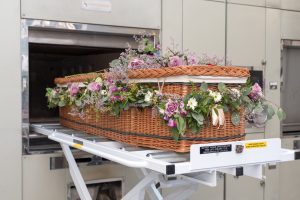4.1 Traditional Disposal Methods: Embalming, Burial & Cremation
Embalming

Embalming is a method/tool of body perseveration dating back to ancient Egypt, where the practice of mummification was used to ensure the preservation of the body, a requirement for the afterlife (Gannal, 2015; mummification, n.d.). Mummification is a multi-step process involving: organ removal, the drying out of the body; the wrapping of the body; the application of resin and oils; and eventually sealing the mummy in a sarcophagus (Gannel, 2015; Mummification, n.d.). There is evidence that mummification was used in many civilizations for thousands of years (e.g., Incan, Aztec, Africa, ancient Europe, Indigenous people of Australia, etc.) (Mummy History, August 21, 2018). In some cultures, evidence points to mummification as a process reserved for royalty or the privileged class, but in others it was more widely available. For example, in Sicily in the 18th and 19th centuries mummifying was also available to the middle class (Giuffra et al., 2006).
VIDEO: The Mummification Process
In this video, the Getty Museum’s Romano-Egyptian mummy Herakleides, is used to explain the Egyptian mummification process.
The modern concept of embalming began in the mid-1800s during the U.S. Civil War as a means to preserve bodies for the transport home for burial (See Chapter on Historical Beliefs and Death-Related Practices). The popularization of embalming and the beautification of the corpse, led to increasing demand for the service and the emergence of the modern funeral industry (Doughty, 2017; FCASMC, n.d.). Current embalming practices involve replacing the body’s blood with chemicals that help prevent body decomposition (Doughty, 2017; Chavez, 2019). The body is then further protected from decay that occurs after burial by the layers of metal and wood that surround caskets (Doughty, 2017) and entombment in a vault (see Burial below). Today, traditional embalming services cost around $800 (Prices, n.d.), however, the U.S. company Summun, is offering modern mummification services. The process takes around 90 days and costs approximately $67,000 USD (Morton, March 28, 2014).
Burial

As noted in the chapter on History of Death and Death-Related Practices, burial is an ancient form of body disposal, however, what we view as traditional burial practices today actually began with the reintroduction of embalming type processes and the professionalization of the funeral industry in the mid-1800s in North America (Walsh, 2017). Burial as a method of body disposal typically requires the purchase of a burial plot (Doughty, 2017), a wood or metal casket, and an outer burial container. Burial containers come in two forms, burial vaults and grave liners. Both function to prevent soil sinkage, which would normally occur as the casket and body decompose, helping to maintain cemetery landscapes. The former also tightly seals the casket to prevent exposure and decay (Doughty, 2017; FCASMC, n.d.). The number of services and associated fees required for a burial today are costly (Understanding Funeral Costs, n.d.), with a typical burial in Canada costing on average around $10,000 (Average Funeral Costs, n.d.).
Cremation

The burning of the dead is another example of an ancient means of body disposal (See Chapter on Historical Beliefs and Death-Related Practices), and was the preferred custom in some cultures like ancient Greek and Roman societies (Naillon, n.d.; Robinson, 2021). Although the practice waned after the 1st century CE, due to the rise of Christianity and its prohibition on cremation, today cremation is one of the most common forms of body disposal. In Canada, the first crematorium opened in 1901 at Mount Royal Cemetery in Outremont Québec. Since then, the practice has continued to grow in popularity among residents of Canada and has become the preferred method of body disposal (Cummings, February 16, 2020). According to a 2021 statistics report, 73% of the body disposals in Canada in 2020 were via cremation (CANA, 2021a) (See infographic below). That number was more than double the cremation rate two decades earlier (CANA, 2021b).

Flame-based cremation involves the use of high heat to reduce human remains to bone and ash and the pulverization of the bone into tiny pieces, which are then placed into a container commonly referred to as an urn (CANA, n.d. -a; Ontario Cremation Services, n.d.). Prior to incineration, the body is placed into a casket or container made of wood or other flammable material (e.g., cardboard). The cultural shift to this form of body disposal has been attributed in part to the lower costs of this procedure — between $2000 and $5000, considerably less than burial (Cummings, February 16, 2020). Cremation also provides families with more time and greater flexibility to determine both the type of memorial service they want and what to do with their loved one’s remains (Canadian Funerals, n.d.). Options for cremated remains are quite diverse. Urn contents can be scattered as part of a memorial process, or urns can be kept in one’s home, buried or placed in a mausoleum or a columbarium (Ontario, 2014). Other newer options for ashes include turning them into a diamond, jewellery or glass art or even fireworks or part of a reef.
CE stands for ‘Common Era’. As with its precursor, ‘AD’, these ways of measuring time reflect a Eurocentric ‘Christian’ perspective that does not appropriately consider the multitude of different ways that the notion of time has been understood by cultures globally.

